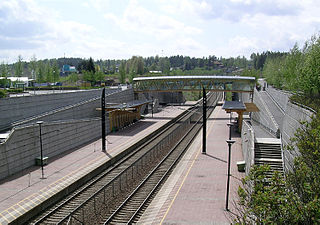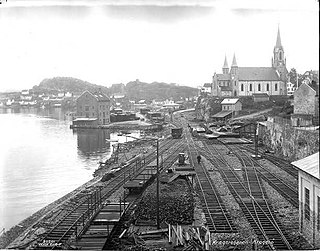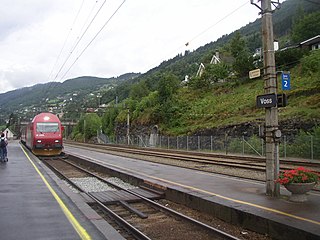Related Research Articles
The Airport Express Train is a Norwegian high-speed airport railway service connecting Oslo Airport to Oslo Central Station in nineteen minutes. Run by Flytoget AS, it operates on the high-speed Gardermoen Line using sixteen GMB Class 71 electric trains. Normal service frequency is once every ten minutes, with five of the services each hour continuing westwards beyond Oslo Central. The extended services serve nine stops within Greater Oslo and take up to 60 minutes.

Vygruppen, branded as Vy, formerly the Norwegian State Railways, branded as NSB, is a government-owned railway company which operates most passenger train services and many bus services in Norway. The company is owned by the Norwegian Ministry of Transport. Its sub-brands include Vy Buss coach services, CargoNet freight trains and the Swedish train transport company Tågkompaniet. In 2009, NSB carried 52 million train passengers and 104 million bus passengers. On 24 April 2019, passenger train and bus services were rebranded as Vy.

The Bergen Line or the Bergen Railway, is a 371-kilometre (231 mi) long scenic standard gauge railway line between Bergen and Hønefoss, Norway. The name is often applied for the entire route from Bergen via Drammen to Oslo, where the passenger trains go, a distance of 496 kilometres (308 mi). It is the highest mainline railway line in Northern Europe, crossing the Hardangervidda plateau at 1,237 metres (4,058 ft) above sea level.

The Gardermoen Line is a high-speed railway line between Oslo and Eidsvoll, Norway, running past Lillestrøm and Oslo Airport, Gardermoen. The line is 64 kilometres (40 mi) long and replaced the older Hoved Line as the main line north-east of Oslo. The older Hoved Line now handles commuter and freight traffic, while the Gardermoen Line handles high-speed passenger trains and freight trains laden with jet fuel for the airport. Both lines are owned by Bane NOR.

NSB Class 73 is a class of 22 electric multiple units built by Adtranz for the Norwegian State Railways. The four-car trains were modifications of Class 71, which was again based on the Swedish X2. The A-series consists of 16 intercity trains; they were delivered in 1999 and 2000 and are used on the Bergen, Dovre and Sørland Lines. The intercity service was branded as Signatur until 2003. The B-series consists of six regional trains delivered in 2002 and used on the Østfold Line. The regional trains were originally part of the Agenda concept. The trains have a power output of 2,646 kilowatts (3,548 hp) and a maximum speed of 210 km/h (130 mph). They have an overall length of 108 meters (354 ft) and have a capacity for 208 seated passengers in the A-series and 250 in the B-series. The trains have a tilting mechanism allowing for faster travel through curves.

NSB Class 72 is a class of 36 electric multiple units built by AnsaldoBreda for the Norwegian State Railways. Delivered between 2002 and 2005, the four-car units operate on the Oslo Commuter Rail and the Jæren Commuter Rail. The trains have a capacity of 310 passengers and the 2,250 kilowatts (3,020 hp) motors allow a maximum speed of 160 kilometres per hour (99 mph). The trains were ordered in 1997, with original delivery dates in 2001 and 2002. NSB also had an option to buy 40 additional units. The first units were not delivered until 2002, and by 2004, still half the trains were not in use. Faults included rust, too heavy train weight, and signaling problems. After the initial troubles, the Class 72 has been a highly successful train for NSB and well liked by the maintenance workers.

The Kragerø Line was a 27-kilometer (17 mi) long railway line between Neslandsvatn and Kragerø in Vestfold og Telemark county, Norway. It was opened on 2 December 1927 as part of the Sørlandet Line. From 10 November 1935, the Sørlandet Line was extended from Neslandsvatn to Arendal, and the Kragerø Line became a branch. It was mostly served with feeder trains, although a through train to Oslo was kept until the 1970s. Falling ridership caused the line to become closed from 1 December 1989, along with many other branch lines. Part of the line remains, although other parts have been demolished.

NSB Biltrafikk was the former road transport division of the Norwegian State Railways from the first bus routes in 1925, as a subsidiary of NSB BA from 1 December 1996, until it was divided into bus operator Nettbuss and truck operator Nettlast on 10 February 2000.

Vy Gjøvikbanen AS is a Norwegian railway company that operates the passenger train service on the Gjøvik Line. A subsidiary of the state-owned Vy, it operates a fleet of nine Class 69g three-car electric multiple units. NSB Gjøvikbanen provides two different services: the Skøyen – Oslo S – Jaren service is part of the Oslo Commuter Rail; while Oslo S – Gjøvik is a regional service, with only limited stops on the route until Grua. Departures are each 40 minutes, with every third train running to Gjøvik.
The Norwegian National Rail Administration was a government agency responsible for owning, maintaining, operating and developing the Norwegian railway network, including the track, stations, classification yards, traffic management and timetables. Safety oversight was the duty of the Norwegian Railway Inspectorate, while numerous operating companies run trains on the lines; the largest being the state owned passenger company Vy and the freight company CargoNet.

Trondheim Airport Station, also known as Værnes Station, is a railway station located within the terminal complex of Trondheim Airport, Værnes in Stjørdal municipality in Trøndelag county, Norway. Situated on the Nordland Line, it serves both express trains and the Trøndelag Commuter Rail both operated by SJ Norge. The station was opened on 15 November 1994 along with a new terminal at the airport, making it the first airport rail link in the Nordic Countries. The station cost 24 million kr, and was built along the existing railway line. In each direction, the station handles one to two hourly commuter rail services, and three daily express services. Travel time to Trondheim is 38 minutes, while it is 9 hours and 5 minutes to Bodø. Access to the airport terminal is outdoors, but sheltered.

Oslo Airport Station, also known as Gardermoen Station, is a railway station located in the airport terminal building of Oslo Airport, Gardermoen in Norway. Located on the Gardermoen Line, it is served by the Airport Express Trains, express trains to Trondheim and Oslo, regional trains to Lillehammer and Skien and commuter trains to Eidsvoll and Kongsberg.
Ofotbanen Drift AS, trading as Ofotbanen, was a Norwegian passenger and freight railway company. The company operated a fleet of six locomotives, three multiple units, 22 passenger and 48 freight cars. The sole service was the passenger train Unionsexpressen between Oslo and Stockholm; it had previously offered freight haulage on contract.
BaneService is a Norwegian government owned railway construction and maintenance company. It is by far the largest subcontractor for Bane NOR and is owned by the Norwegian Ministry of Transport and Communications.
Strømmens Værksted A/S was an industrial company based in Skedsmo, Norway, specialising in the production of rolling stock. Founded in 1873, it remains as a part of Bombardier Transportation. The plant is located just off Hovedbanen west of Strømmen Station.

The Voss Line is a railway line from Bergen to Voss in Vestland, Norway. It opened on 11 July 1883 and was extended to Oslo as the Bergen Line on 27 November 1909. It was built as 1,067 mm narrow gauge, but converted to 1,435 mmstandard gauge with the connection with the Bergen Line. It was electrified in 1954, and shortened by the Ulriken Tunnel in 1963.

The Norwegian Union of Railway Workers is a trade union in Norway. It was formed on 20 November 1892, and mainly organizes workers in Norges Statsbaner—with the exception of locomotive drivers— and the Norwegian National Rail Administration, including related companies such as BaneTele, Nettbuss, Nettlast, Malmtrafik, MiTrans, Mantena, Trafikkservice, CargoNet, Baneservice, Arrive, Ofotbanen AS, NSB Gjøvikbanen and Flytoget.
Arne Wam is a Norwegian journalist and civil servant, who has had several leading positions in the Norwegian Broadcasting Corporation (NRK) and the Norwegian State Railways (NSB).

The history of rail transport in Norway had begun by 1805.

The Norwegian State Railways was a state-owned railway company that operated most of the railway network in Norway. The government agency/directorate was created in 1883 to oversee the construction and operation of all state-owned railways in Norway. On 1 December 1996, it was demerged to create the infrastructure operator Norwegian National Rail Administration, the train operator Norwegian State Railways and the Norwegian Railway Inspectorate. The name was taken by the train operator, although the infrastructure operator remained a government agency and is the legal successor.
References
- ↑ "Osmund Ueland". Store norske leksikon (in Norwegian). 7 January 2021. Retrieved 20 July 2023.
- ↑ "Ueland klar for ny lederstilling". Dagens Næringsliv (in Norwegian). 6 March 2001. Retrieved 20 July 2023.